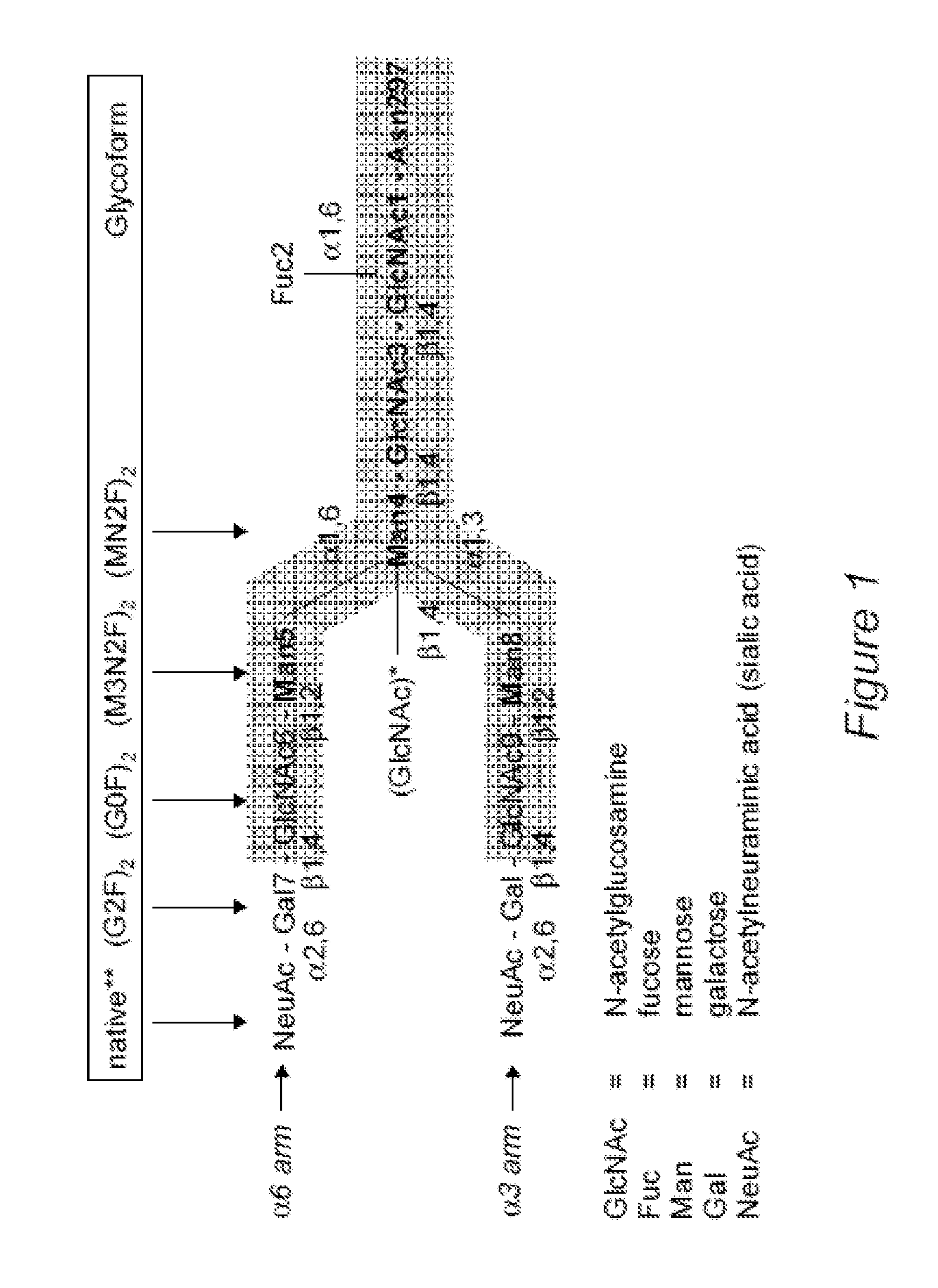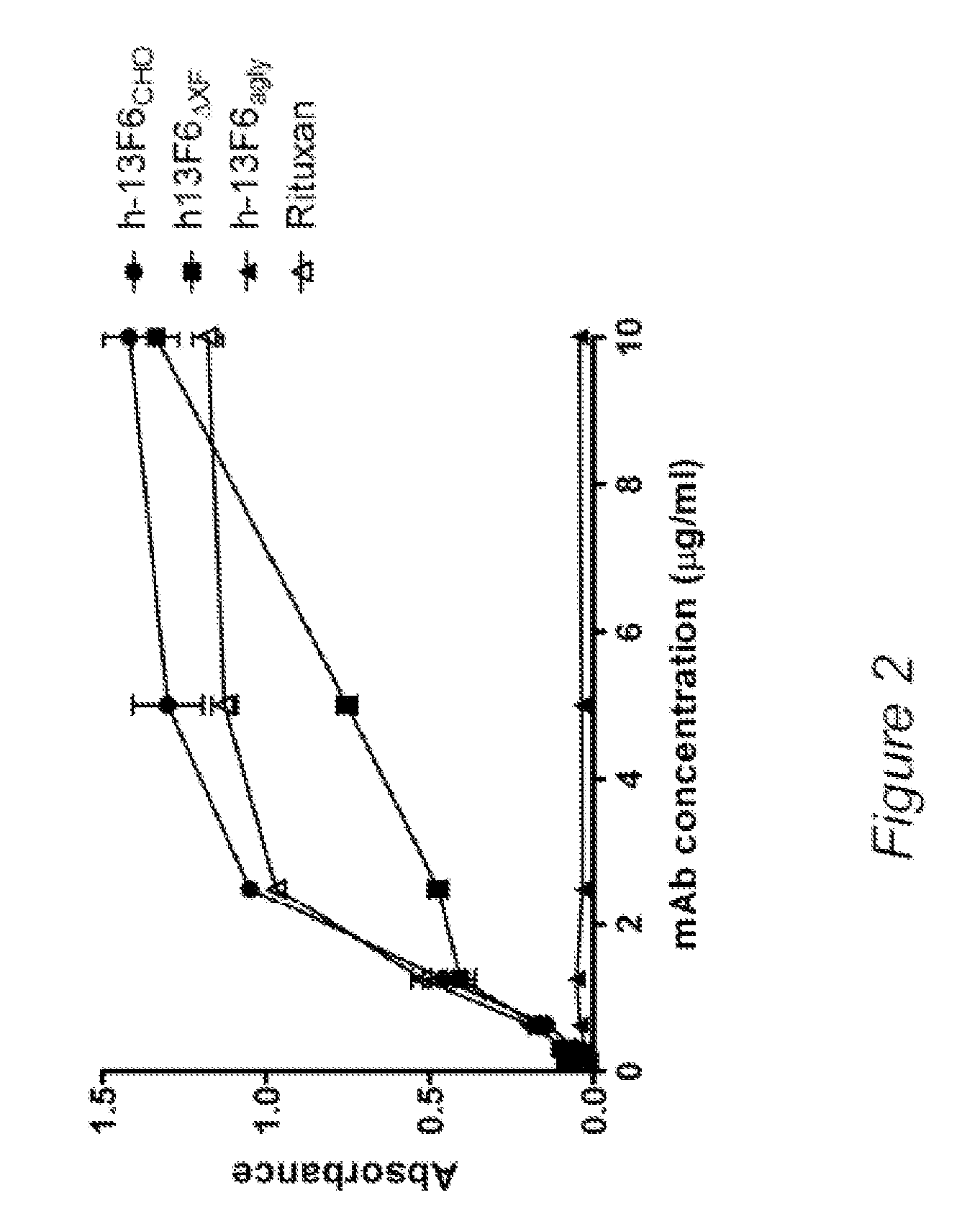MONOCLONAL ANTIBODIES WITH ALTERED AFFINITIES FOR HUMAN FCyRI, FCyRIIIa, AND C1q PROTEINS
a technology of affinities and monoclonal antibodies, which is applied in the field of antibodies and antigen binding fragments, can solve the problems of severe impairment of adcc and cdc by removing n-glycan, difficult isolation of human igg having a particular homogeneous glycan from this mixture, and interfere with results and data interpretation. , to achieve the effect of reducing the dose of a marketed mab, improving the efficacy, and reducing the dose dose dos
- Summary
- Abstract
- Description
- Claims
- Application Information
AI Technical Summary
Benefits of technology
Problems solved by technology
Method used
Image
Examples
examples
Experimental Procedures
[0167]N. benthamiana expression vectors - Heavy and light chain variable regions joined with human constant regions were first codon optimized for expression in Nicotiana benthamiana. An aglycosylated mAb was designed by mutating the heavy chain constant region N-glycosylaton site (N297A). Genes were synthesized (GeneArt, AG) and subsequently cloned into plant (TMV and PVX) expression vectors (Icon Genetics, GmbH [34,35]), followed by transformation into Agrobacterium tumefaciens strain ICF320.
[0168]Production of mAbs in N. benthamiana—For transient expression of mAb genes in planta, we used the “magnifection” procedure (Icon Genetics, Halle (Saale), Germany) as described [34,35], with minor modifications. Plants grown for 4 weeks in an enclosed growth culture room with 20-23° C. were used for vacuum infiltration. Equal volumes of overnight-grown Agrobacterium cultures were mixed in the infiltration buffer 10 mM MES pH 5.5 and 10 mM MgSO4 resulting in a 1:1000...
example i
Novel Glycoforms on mAbs Produced in CHO, Nicotiana and Yeast
[0175]Three mAbs were used in order evaluate the effects of different glycoforms on FcγR and c1q binding. The mAbs and their N-linked glycans are listed in Table 2. Their specificities respresent an anti-viral mAb (mAb 13F6, anti-Ebola virus [42], an anti-B cell mAb (anti-CD20, rituximab [43]) and an anti-tumor mAb (anti-HER2, trastuzumab [44]). The various mAb glycoforms were produced in three different systems. The first system, Chinese hamster ovarian (CHO) cells, are currently the most commonly used platform to manufacture FDA approved recombinant mAbs. A stable wild-type CHO line was used to produce the mAbs that contained typical glycans (+fucose and galactose) commonly found on recombinant antibodies. A second CHO line (lec8 [48]) was used to produce mAbs that were devoid of galactose residues. In order to inhibit fucose glycosylation in this line, a gene knockout approach was used as previously described [36] resul...
example ii
Affinities of mAbs for Fc Receptors and C1q
[0181]Affinity of mAbs for FcγRI (CD64)—Surface plasmon resonance (SPR) was performed to determine the affinities of mAbs for recombinant human FcγRI (Table 3), a receptor important for ADCC [3,10]. In general, mAbs lacking fucose have significantly higher affinity for human FcγRI compared to fucosylated mAbs (P<0.05 in all cases). Binding by the aglycosylated mAb was significantly (P<0.05) lower than all the other mAbs tested.
TABLE 3KD (×10−8M)MAbFcγRI (CD64)FcγRIIIA (CD16)11.6 ± 0.32.5 ± 0.321.5 ± 0.32.6 ± 0.334.2 ± 1.27.2 ± 1.241.5 ± 0.42.4 ± 0.351.6 ± 0.32.7 ± 0.364.3 ± 1.27.3 ± 1.271.4 ± 0.42.6 ± 0.381.3 ± 0.42.5 ± 0.394.2 ± 0.7 15 ± 1.6101.4 ± 0.42.3 ± 0.3111.5 ± 0.42.4 ± 0.3124.5 ± 1.37.5 ± 1.41334 ± 16 12 ± 1.1
[0182]Affinity of mAbs for human FcγRIIIA (CD16)—Surface plasmon resonance was also performed with recombinant FcγRIIIA (Table 3), a receptor important for induction of ADCC by NK cells [47]. Among all mAbs, the aglycosylated ...
PUM
| Property | Measurement | Unit |
|---|---|---|
| pH | aaaaa | aaaaa |
| pH | aaaaa | aaaaa |
| pH | aaaaa | aaaaa |
Abstract
Description
Claims
Application Information
 Login to View More
Login to View More - R&D
- Intellectual Property
- Life Sciences
- Materials
- Tech Scout
- Unparalleled Data Quality
- Higher Quality Content
- 60% Fewer Hallucinations
Browse by: Latest US Patents, China's latest patents, Technical Efficacy Thesaurus, Application Domain, Technology Topic, Popular Technical Reports.
© 2025 PatSnap. All rights reserved.Legal|Privacy policy|Modern Slavery Act Transparency Statement|Sitemap|About US| Contact US: help@patsnap.com



